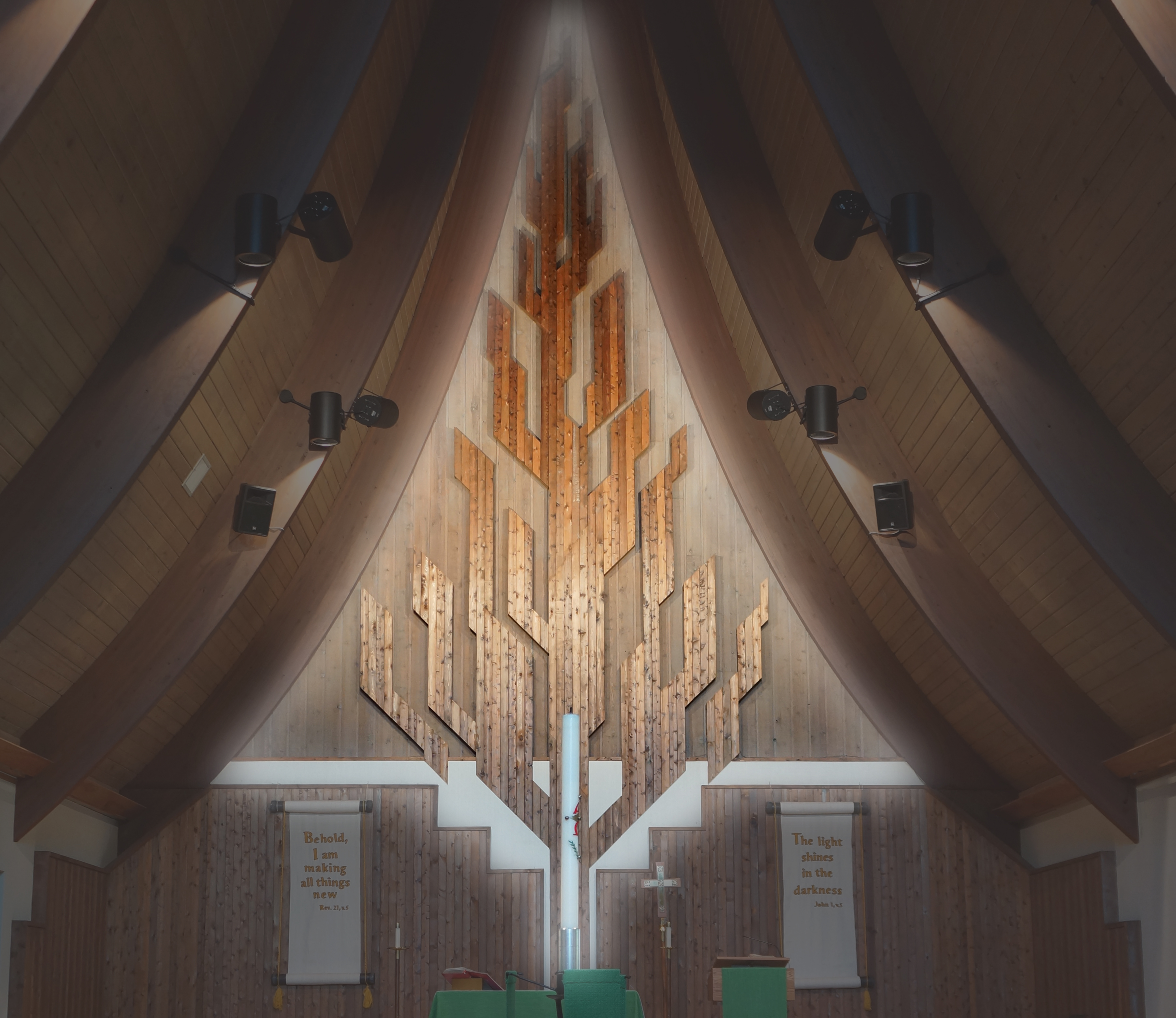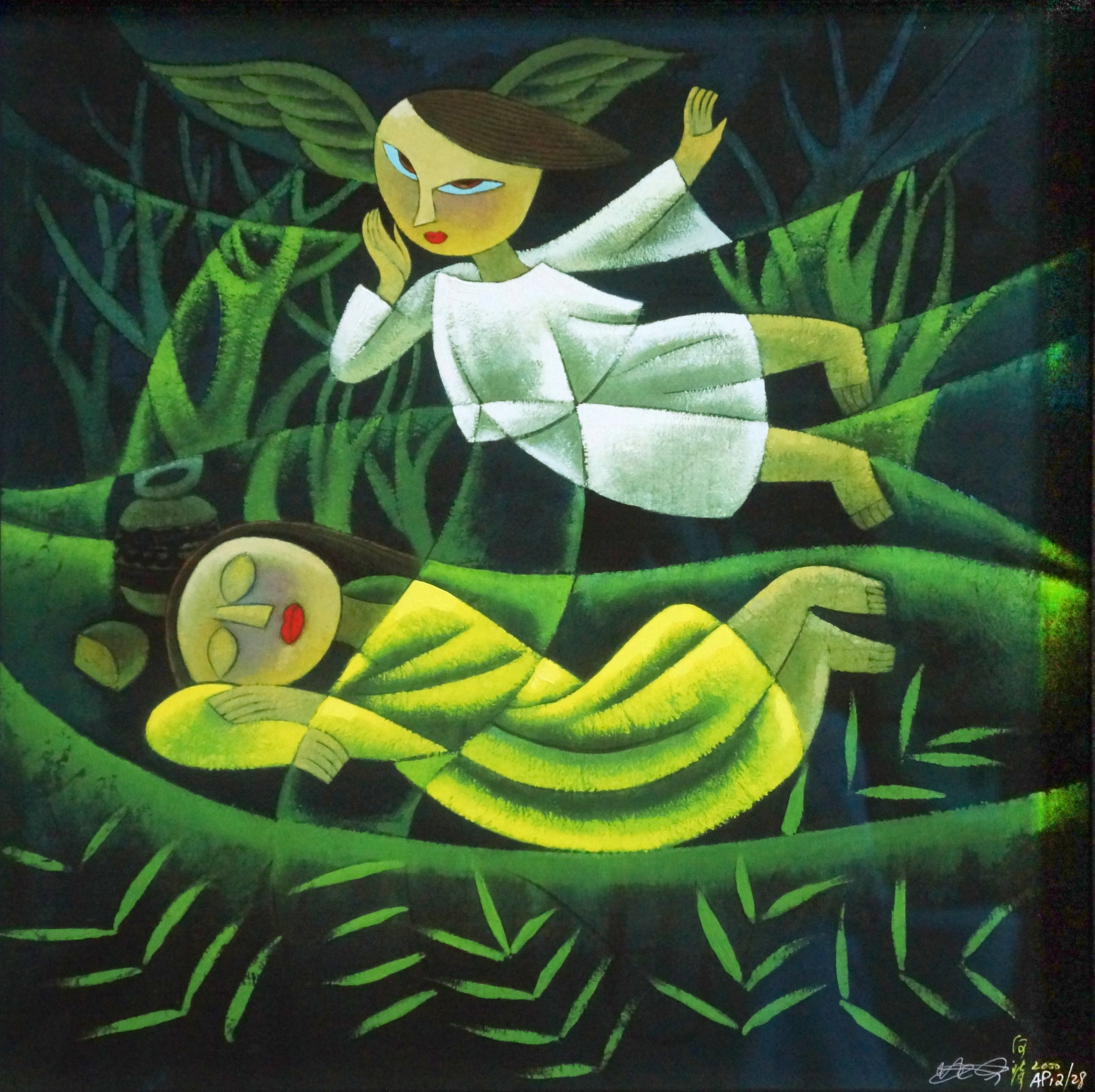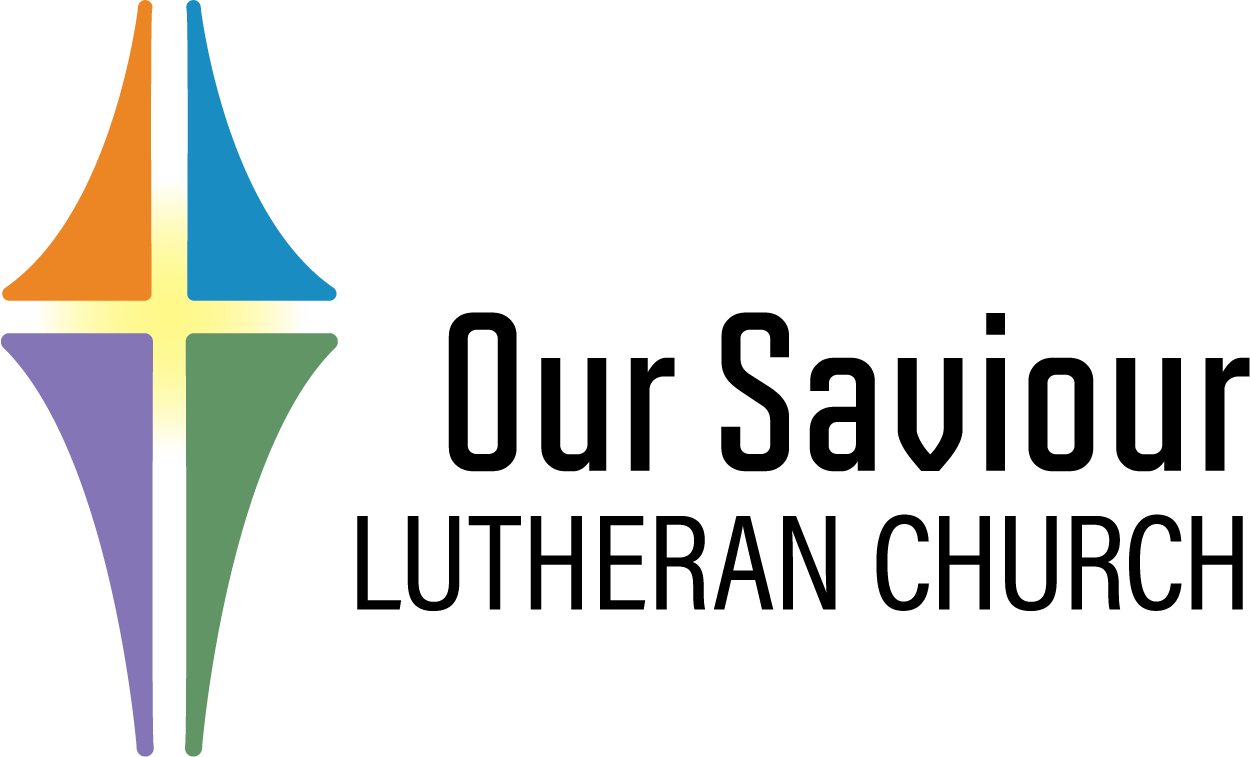Visual Arts
Our Nave
At the center of the nave stands a marble baptismal font, a gift from members of Holy Trinity Lutheran Church in 1962. The paraments and stoles were designed and hand-woven by OSLC member Bea Stromberg. A series of banners called Journey, designed by Linda Witte Henke, was purchased in 2019 with Memorial Funds in honor of Jo Amstutz. The processional cross was given to OSLC in 1988 in memory of Jennie Dana. Against the north wall, behind the altar, is the Tree of Life, designed by the late liturgical designer Charles Pohlmann and constructed in 1996 by then-OSLC member Ted Marshall. The west wall is lined with seven wood carvings depicting the life of Christ commissioned from the late Nigerian carver Lamidi Fakeye. The prints of paintings on the east wall, Samaritan Woman at the Well, Sleeping Elijah and Supper at Emmaus, are by liturgical artist He Qi. The center piece is given by the Church Council in honor of Sam Rasmy for his long-time service as Financial Secretary of OSLC. The Last Supper, by Guatemalan artist Angelina Quic Ixtamer, was purchased by the 2014 Guatemala Mission Team. Hung at the back of our name in the family room is Archangel by Grace Benedict, purchased from the Daehler Gift Art Fund established to honor Rev. Dwayne P. Daehler, OSLC Pastor 1981 to 1999.
Our Artwork
Baptismal Font
The Baptismal Font was a gift from members of Holy Trinity Lutheran Church. They had just completed their new church building on North 21st Street in 1962. Some children of our own members (among them Barbara Richardson and the Ahlrichs) had been baptized at this font, when Holy Trinity was located on North 9th Street, near St. James Lutheran Church.
The font is made from three sections of marble: the base, the pedestal and the bowl. A particularly distinctive feature is the carving of flowers on the pedestal.
The font stood at the front of the nave of the just-completed Our Saviour building for a year or two, until it was thought not to be appropriate to the modern church setting. Instead, a silver bowl, placed on a small shelf on the front wall at the left of the altar, was used for baptisms.
Then the base was “stored” under the original rear entrance to the church, for nearly 20 years, half buried in the dirt. The pedestal and the bowl lay in a far corner of the furnace room. Several of the older members of OSLC watched these pieces carefully during this period, since the old font was particularly meaningful to them.
After church on one warm Sunday in late 1979, we mentioned the situation to Pastor Dennis Ormseth (then the Lutheran Campus Minister). In his light blue suit, he helped Jim and me carry the base inside and set the three pieces back together. He promptly observed that they were very special and ought to be used.
We thereupon contacted Mr. Don Cassini, the local expert and dealer in marble. (His family’s firm was Cassini Tile and Terrazzo Co., Inc., at 800 S. Earl Avenue, Lafayette. When the last Cassini retired, the firm was sold, but their well-respected name was preserved.)
Mr. Cassini was immediately eager to restore this font and provided us with considerable information about it:
“The marble, white but having gray highlights running through it, is Carrara Marble, from the famous quarries near Carrara, Italy (a place we once visited). This is the source of stone from which many famous statues, even before Medieval times, were carved. Our particular portion of marble likely was shipped through Chicago early in the 1900’s. This font was carved by the Del Prado Marble Company, which operated in the United States from 1800 to 1950. With about 100 factories, it was the largest such firm in the country, producing about 90% of the marble fixtures in this country’s churches. Another fine example of the best of their work is the magnificent marble altar rail in the chapel of St. Elizabeth Hospital.”
Mr. Cassini finished restoring our font in 1980 and installed it securely at the front of the nave. Subsequently, it was moved back to its present more prominent and theologically correct position near the entrance to the sanctuary, where it now is a focal point of the nave.
Eileen and Jim Richardson



The Tree of Life
Behind the altar, the Tree of Life represents the literal tree of life in Genesis, and from Revelation, everlasting life granted to those who display fruits of the spirit and righteousness aligned with God’s principles.
Designed by Charles Pohlmann ~ Constructed by Ted Marshall

Archangel
Grace Benedict. Watercolor. Purchased in honor of the ministry of
Rev. Dwayne Daehler, OSLC Pastor, 1981-1999.
From the Artist: The statue of the angel is found at Crown Hill Cemetery, Indianapolis. It was one of the earlier drawings in a body of work (still relevant to me as a subject as I continue the use of cemetery sculpture) following acceptance of my proposal to the Indiana Arts Commission for an individual artist’s grant. I sketched and painted this angel first, on site, in watercolor and ink washes since the light was so clear that crisp fall day. The watercolor is on my website gracebenedict.com under statuary and you can see the background orange foliage. I then photographed the sculpture, cropping in to focus on the face and spread wings. Again the crisp fall light created strong blue shadows and contrast which I tried to capture in my rendering. I recall the sculpture had been repaired – one of the hands was not original. The profile, posture and angle of the head appealed to me with the hair around the face, as well as the angular folds of the drapery – quite large in size and with a commanding presence – thus the title “archangel” (high ranking – references to Gabriel or Michael throughout art history classes, paintings and illuminated manuscripts, etc.)

South Wall Window
The window on the south wall of the church was designed by Emily Ohland and fabricated by Lafayette Glass. It was installed in 2019.

The Last Supper
This painting was acquired by OSLC members while on mission work in Guatemala
Prints of Paintings by He Qi
Samaritan Woman at the Well; Sleeping Elijah; Supper at Emmaus (left to right)
The lower level classrooms in the building contain additional smaller prints by He Qi



The People of Guatemala
Domingo Quic. Purchased in honor of Rev. Will Peugeot,
OSLC Pastor, 2001-2019.
Carvings by Lamidi Olonade Fakeye
Lamidi Olonade Fakeye was a Nigerian Master Sculptor who lived from 1928 – 2009. On the west side of the nave are seven carvings carved of African Cordia wood. These panels, depicting scenes in the life of Jesus, were executed while Lamidi was artist-in-residence at Hope College. Figures appear in traditional Yoruba dress. The artwork was Commissioned by Our Savior Lutheran Church in 1996.

